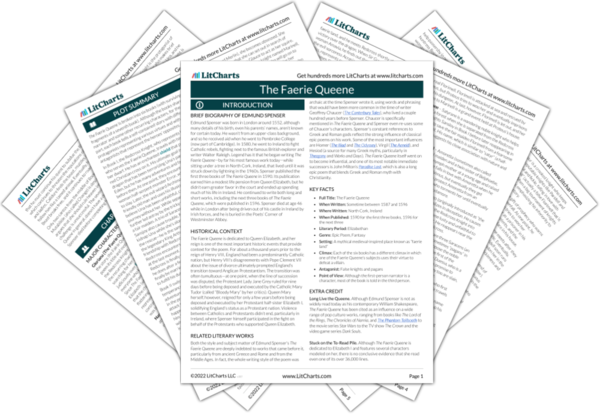Virtue, Allegory, and Symbolism
Edmund Spenser’s The Faerie Queene is divided into six books, and each book explores a different virtue: holiness, temperance, chastity, friendship, justice, and courtesy. While there are recurring characters who appear in multiple books, the main character is different for each book and is always a knight who represents the book’s central virtue. For example, the protagonist of Book I is the Redcross Knight, who embodies the book’s theme of holiness. His name comes…
read analysis of Virtue, Allegory, and SymbolismBritish Identity and Nationalism
Edmund Spenser’s The Faerie Queene begins with a grand dedication to Queen Elizabeth (the reigning monarch in Britain at the time) in which he writes that all the labor that went into his poem is dedicated to her. The character of the Faerie Queene herself (also called Queen Gloriana) is always virtuous and correct, making her a flattering stand-in for the real-life Queen Elizabeth. Other characters also have clear parallels to Elizabeth, such as the…
read analysis of British Identity and NationalismProtestantism
Though Edmund Spenser’s The Faerie Queene draws influences from a variety of different religious traditions—including the mythology of ancient Greece and Rome—it is also an unapologetic defense of Anglican Protestantism. Many of the book’s themes, like justice or friendship, are not necessarily religious, and others like holiness or chastity play a role in many different religions. Nevertheless, a close look at the events and characters in The Faerie Queene reveals that many of the villains…
read analysis of Protestantism
Deception and Lies
Throughout Edmund Spenser’s The Faerie Queene, evil characters disguise their identities and tell lies in order to trick heroic characters into doing things they wouldn’t otherwise do. Archimago in Book I is one of the earliest examples of this type of trickster character, using magic and some mischievous sprites in order to trick the Redcross Knight into believing that his chaste lady Una has been unfaithful to him. Even more extreme is the Blatant…
read analysis of Deception and LiesLove and Friendship
Throughout Edmund Spenser’s The Faerie Queene, there are two types of relationships that occur again and again. One is love (typically between a knight and a lady) and the other is friendship (often between equally matched knights who share common goals, or between knights and squires). In Spenser’s epic poem, characters’ morality often comes through most clearly in their relationships with others, meaning that heroic characters are kind and courteous in their relationships while…
read analysis of Love and FriendshipThe Role of Women
Edmund Spenser’s The Faerie Queene has a complicated relationship with women. On the one hand, the poem reflects biases against women that were prevalent when it was written. Under coverture, a legal practice that was common in England in the 1500s and for centuries afterwards, women had no legal status, being “covered” by their husbands, and so they couldn’t own land in most cases unless they were widowed. The Amazon queen Radigund is an…
read analysis of The Role of Women






